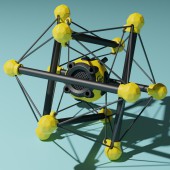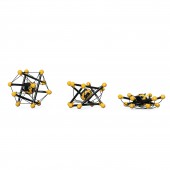DESIGN NAME:
Tensegrity
PRIMARY FUNCTION:
Deployable Sensor for Disaster Area
INSPIRATION:
Tensegrity structures are a type of stiff beam coupled with many strings that generate tension that can sustain the impact of a collision. Inspired by the structure, the sensor can be deployed from more than 50 m above the ground without the use of an additional device (parachute).
UNIQUE PROPERTIES / PROJECT DESCRIPTION:
Tensegrity sensor for disaster site, which could be dropped from the sky (drone) to gather information for the emergencyresponse crew (gas leaks, visuals, and audios). Once the drone arrives at the spot, many tensegrity modulesstored in a basket with an autonomous deployment system are deployed on multiple locations. The sensors can be delivered to disaster areas where humans are unable to approach.
OPERATION / FLOW / INTERACTION:
Initially, four sensor modules are carried in a collapsed hexagonal box attached to the drone. When the drone approaches the point of interest (to collect data), the bottom panel of the box opens, allowing the sensor module to be dropped from a great height. The module rapidly deploys into the fully tensioned tensegrity structure, absorbing enough energy from impact with the ground. The module collects data for the reaction strategy by deploying various sensors.
PROJECT DURATION AND LOCATION:
The project started in August 2021 in Seoul, Korea and finished in March 2022 in Berkeley, California.
FITS BEST INTO CATEGORY:
Product Engineering and Technical Design
|
PRODUCTION / REALIZATION TECHNOLOGY:
The tensegrity module's goal is to offer the response team in a catastrophe region with a range of data. This data contains auditory or visual alerts that may have been generated by survivors, as well as a collection of gas leaks that may have enabled focused response to prevent larger accidents. Enclosures for the current mudules are made with SLA 3D printing, and many wireless sensors are enclosed. Furthermore, commercial nylon threads were employed to give the necessary tension for the framework.
SPECIFICATIONS / TECHNICAL PROPERTIES:
Maximum size of 150 mm x 150 mm x 150 mm when deployed, and 150 mm x 150 mm x 60 mm when collapsed.
TAGS:
Tensegrity, soft robot, disaster response, emergency sensors
RESEARCH ABSTRACT:
This design is based on the tensegrity structure, which has sparked academic interest due to its energy absorption qualities with a specially constructed mix of rigid rod and strings. Through interviews and observations, we discovered that the quick reaction team frequently lacks the data required for the response plan, particularly in the case of a large-scale disaster such as a forest fire. Because drones have limited battery life and require pilot control to gather information, we developed tensegrity modules that can be easily deployed to many places in need of sensory input.
CHALLENGE:
Finding appropriate materials for the string was extremely difficult because it needed to offer enough tension as well as strength to endure the drop. Another challenge was the module's assembly, which required many stiff rods to be linked at the same time. We solved this problem by creating a 3D printed jig that holds the component in place during assembly and using nylon threads to give sturdiness as well as enough tension for the construction.
ADDED DATE:
2022-03-06 02:29:05
TEAM MEMBERS (3) :
Team Director: Dr. Alice M. Agogino, Director of controls engineering: Brian Cera and Director of operation : Deniz Dogruer
IMAGE CREDITS:
Daniel Lim, 2021.
|









